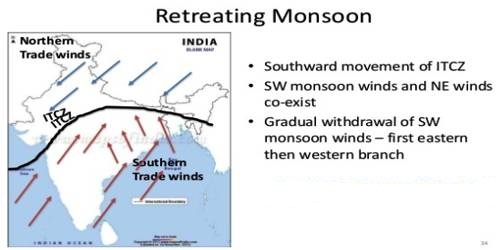Season of Retreating Monsoon in Indian Subcontinent
Retreating Monsoon is an exception to that rule occurs along the southeastern coast of India and for some distance inland. The months of October and November are known for retreating monsoons. By the end of September, the southwest monsoon becomes weak as the low-pressure trough of the Ganga plain starts moving southward in response to the southward march of the sun. The monsoon retreats from the western Rajasthan by the first week of September. It withdraws from Rajasthan, Gujarat, Western Ganga plain, and the Central Highlands by the end of the month. By the beginning of October, the low pressure covers northern parts of the Bay of Bengal and by early November, it moves over Karnataka and Tamil Nadu. By the middle of December, the center of low pressure is completely removed from the Peninsula.
The retreating southwest monsoon season is marked by clear skies and rise in temperature. The land is still moist. Owing to the conditions of high temperature and humidity, the weather becomes rather oppressive. This is commonly known as the ‘October heat’. In the second half of October, the mercury begins to fall rapidly, particularly in northern India. The weather in the retreating monsoon is dry in north India but it is associated with rain in the eastern part of the Peninsula. Here, October and November are the rainiest months of the year.
Temperature during Retreating Monsoon Season
- With the retreat of the monsoons, the clouds disappear and the sky becomes clear.
- The day temperature starts falling steeply.
- The diurnal range of temperature increases due to lack of cloud cover.
The widespread rain in this season is associated with the passage of cyclonic depressions which originate over the Andaman Sea and manage to cross the eastern coast of the southern Peninsula. These tropical cyclones are very destructive. The thickly populated deltas of the Godavari, Krishna, and Kaveri are their preferred targets. Every year cyclones bring disaster here. A few cyclonic storms also strike the coast of West Bengal, Bangladesh and Myanmar. A bulk of the rainfall of the Coromandel coast is derived from these depressions and cyclones. Such cyclonic storms are less frequent in the Arabian Sea.














